Templated Sphere Phase Liquid Crystals for Tunable Random Lasing
Abstract
:1. Introduction
2. Materials and Methods
3. Results and Discussion
4. Conclusions
Acknowledgments
Author Contributions
Conflicts of Interest
References
- Zhu, J.L.; Ni, S.B.; Chen, C.P.; Wu, D.Q.; Song, X.L.; Chen, C.Y.; Lu, Y.K.; Shieh, H.D. Chiral-induced self-assembly sphere phase liquid crystal with fast switching time. Appl. Phys. Lett. 2014, 104, 091116. [Google Scholar] [CrossRef]
- Frolov, S.V.; Vardeny, Z.V.; Yoshino, K.; Zakhidov, A.; Baughman, R.H. Stimulated emission in high-gain organic media. Phys. Rev. B 1999, 59, R5284–R5287. [Google Scholar] [CrossRef]
- Polson, R.C.; Vardeny, Z.V. Random lasing in human tissues. Appl. Phys. Lett. 2004, 85, 1289–1291. [Google Scholar] [CrossRef]
- Wiersma, D.S.; Van, M.P.; Lagendijk, A. Coherent backscattering of light from amplifying random media. Appl. Phys. Lett. 2015, 75, 1739–1742. [Google Scholar] [CrossRef] [PubMed]
- Zhu, J.L.; Li, W.H.; Sun, Y.B.; Lu, J.G.; Song, X.L.; Chen, C.Y.; Zhang, Z.D.; Su, Y.K. Random laser emission in a sphere-phase liquid crystal. Appl. Phys. Lett. 2015, 106, 191903. [Google Scholar] [CrossRef]
- Hu, D.C.; Li, W.H.; Chen, X.W.; Ma, X.L.; Lee, Y.J.; Lu, J.G. Template effect on reconstruction of blue phase liquid crystal. J. Soc. Inf. Disp. 2016, 24, 593–599. [Google Scholar] [CrossRef]
- Zhou, Y.; Huang, Y.H.; Ge, Z.B.; Chen, L.P.; Hong, Q.; Wu, T.X.; Wu, S.T. Enhanced photonic band edge laser emission in a cholesteric liquid crystal resonator. Phys. Rev. E 2006, 74, 061705. [Google Scholar] [CrossRef] [PubMed]
- Wiersma, D.S. The physics and applications of random lasers. Nat. Phys. 2008, 4, 359–367. [Google Scholar] [CrossRef]
- Morris, S.M.; Ford, A.D.; Pivnenko, M.N.; Coles, H.J. Enhanced emission from liquid-crystal lasers. J. Appl. Phys. 2005, 97, 023103. [Google Scholar] [CrossRef]
- Furnmi, S.; Yokoyama, S.; Otomo, A.; Mashiko, S. Electrical control of the structure and lasing in chiral photonic band-gap liquid crystals. Appl. Phys. Lett. 2003, 82, 16–18. [Google Scholar] [CrossRef]
- Kasano, M.; Ozaki, M.; Yoshino, K.; Ganzke, D.; Haase, W. Electrically tunable waveguide laser base on ferroelectric liquid crystal. Appl. Phys. Lett. 2003, 82, 4026–4028. [Google Scholar] [CrossRef]
- Lin, T.H.; Jau, H.C.; Chen, C.H.; Chen, Y.J.; Wei, T.H.; Chen, C.W.; Fuh, A.Y. Electrically controllable laser based on cholesteric liquid crystal with negative dielectric anisotropy. Appl. Phys. Lett. 2006, 88, 061122. [Google Scholar] [CrossRef]
- Chanishvili, A.; Chilaya, G.; Petriashvili, G.; Barberi, R.; Bartolino, R.; Cipparrone, G.; Mazzulla, A.; Oriol, L. Phototunable lasing in dye-doped cholesteric liquid crystals. Appl. Phys. Lett. 2003, 83, 5353–5355. [Google Scholar] [CrossRef]
- Furumi, S.; Yokoyama, S.; Otomo, A.; Mashiko, S. Phototunable photonic bandgap in a chiral liquid crystal laser device. Appl. Phys. Lett. 2004, 84, 2358–2363. [Google Scholar] [CrossRef]
- Shibaev, P.V.; Sanford, R.L.; Chiappetta, D.; Milner, V.; Genack, A.; Bobrovsky, A. Light controllable tuning and switching of lasing in chiral liquid crystals. Opt. Express 2005, 13, 2358–2363. [Google Scholar] [CrossRef] [PubMed]
- Ohta, T.; Song, M.H.; Tsunoda, Y.; Nagata, T.; Shin, K.C.; Araoka, F.; Takanishi, Y.C.; Ishkawa, K.; Watanabe, J.J.; Nishimura, S.; et al. Monodomain film formation and lasing in dye-doped polymer cholesteric liquid crystals. Jpn. J. Appl. Phys. 2004, 43, 6142. [Google Scholar] [CrossRef]
- Shibaev, P.V.; Kopp, V.; Genack, A.; Hanelt, E. Lasing from chiral photonic band gap materials based on cholesteric glasses. Liq. Cryst. 2003, 30, 1391–1400. [Google Scholar] [CrossRef]
- Finkelmann, H.; Kin, S.T.; Munoz, A.; Muhoray, P.P.; Taheri, B. Tunable mirrorless lasing in cholesteric liquid crystalline elastomers. Adv. Mater. 2001, 13, 1069–1072. [Google Scholar] [CrossRef]
- Morris, S.M.; Ford, A.D.; Pivnenko, M.N.; Coles, H.J. Electronic control of nonresonant random lasing from a dye-doped smectic A* liquid crystal scattering device. Appl. Phys. Lett. 2005, 86, 141103. [Google Scholar] [CrossRef]
- Huang, Y.H.; Zhou, Y.; Doyle, C.; Wu, S.T. Tuning the photonic band gap in cholesteric liquid crystals by temperature-dependent dopant solubility. Opt. Express 2006, 14, 1236–1242. [Google Scholar] [CrossRef] [PubMed]
- Cao, H.; Zhao, Y.G.; Ong, H.C.; Chang, R.P.H. Far-field characteristics of random lasers. Phys. Rev. B 1999, 59, 15107–15111. [Google Scholar] [CrossRef]
- Woltman, S.J.; Crawford, G.P. Tunable cholesteric liquid crystals lasers through in-plane switching. Proc. SPIE 2007, 6487. [Google Scholar] [CrossRef]
- Cao, H.; Zhao, Y.G.; Ho, S.T.; Seeling, E.W.; Wang, Q.H.; Chang, R.P.H. Random laser action in semiconductor power. Phys. Rev. Lett. 1999, 82, 2278–2281. [Google Scholar] [CrossRef]
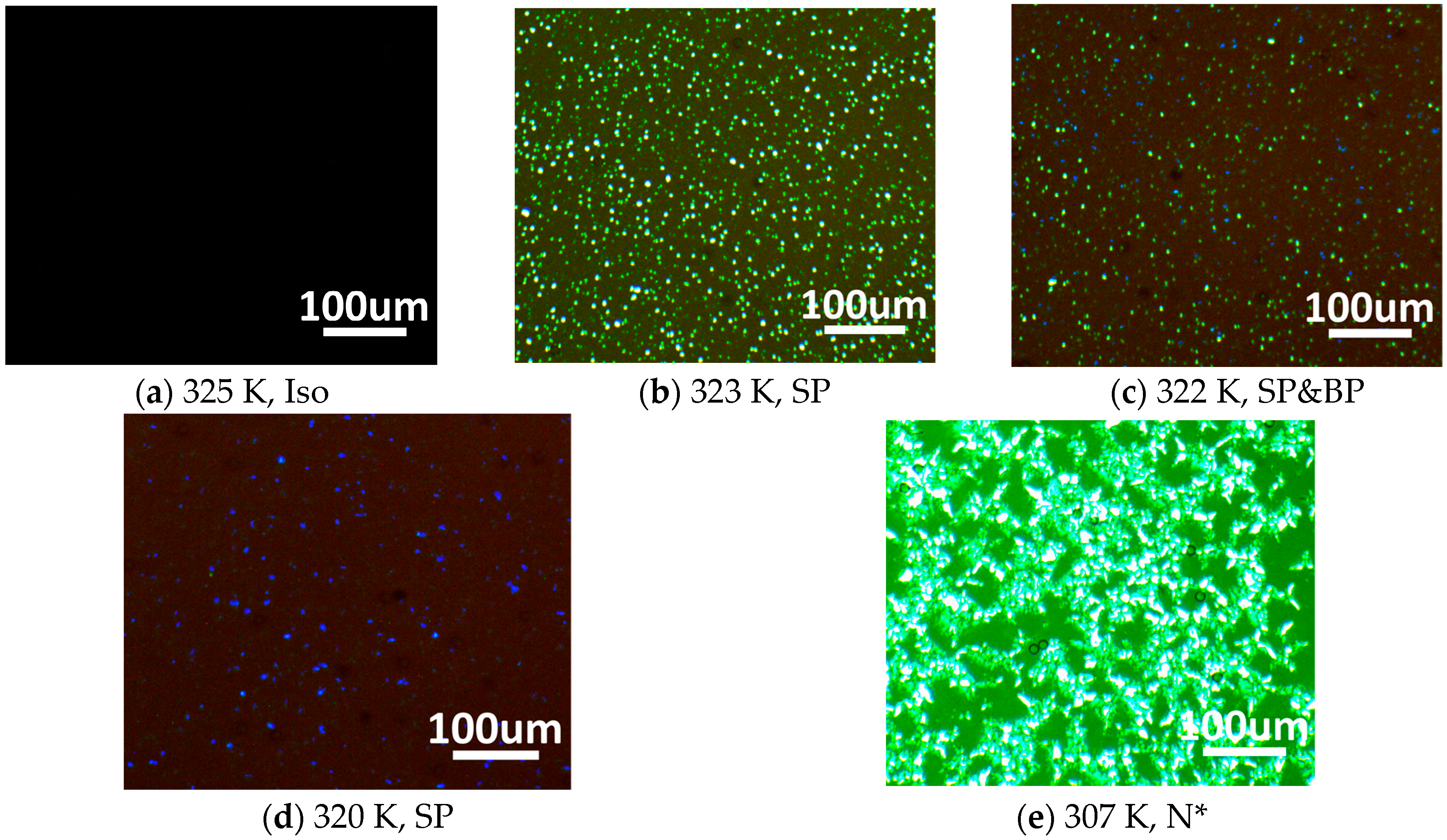

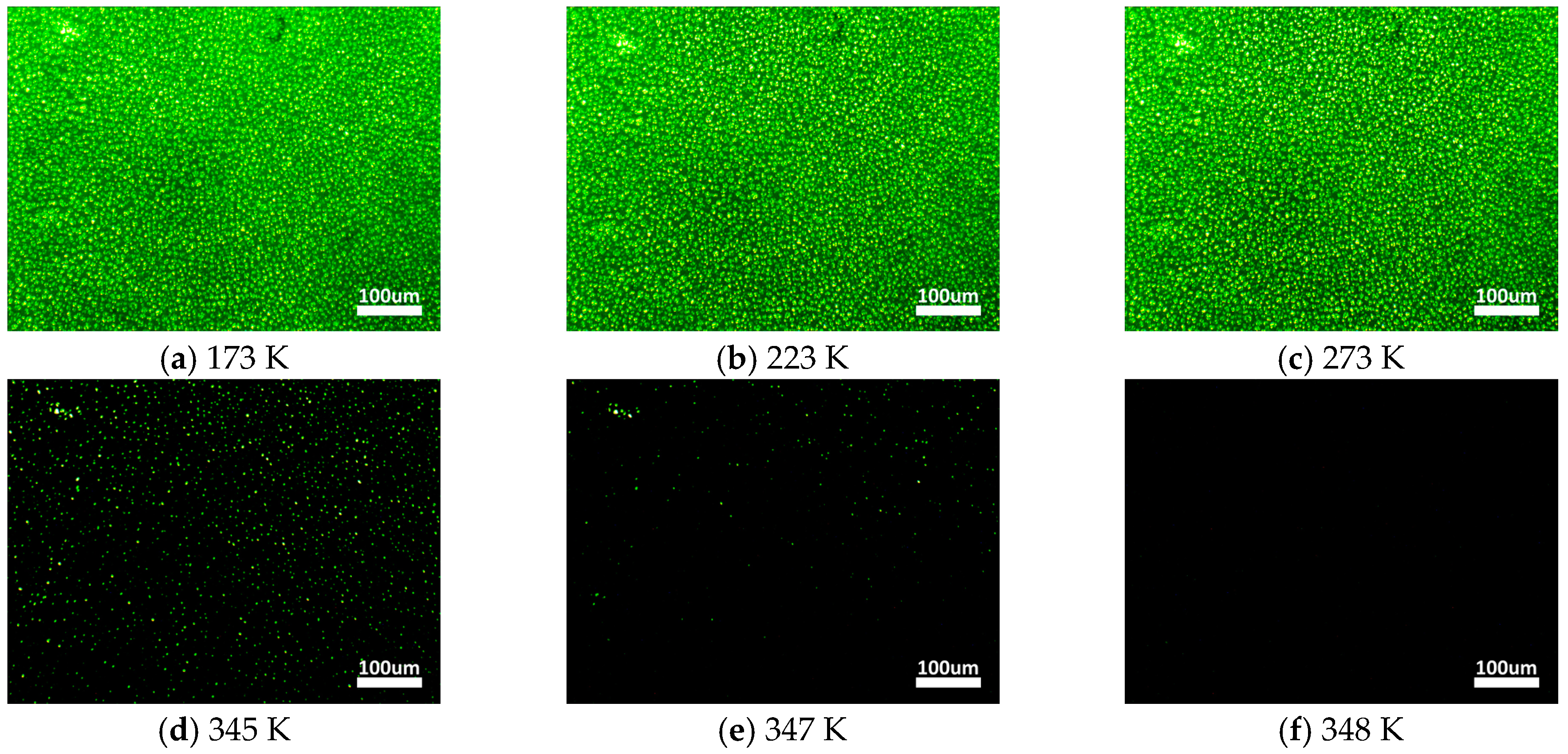

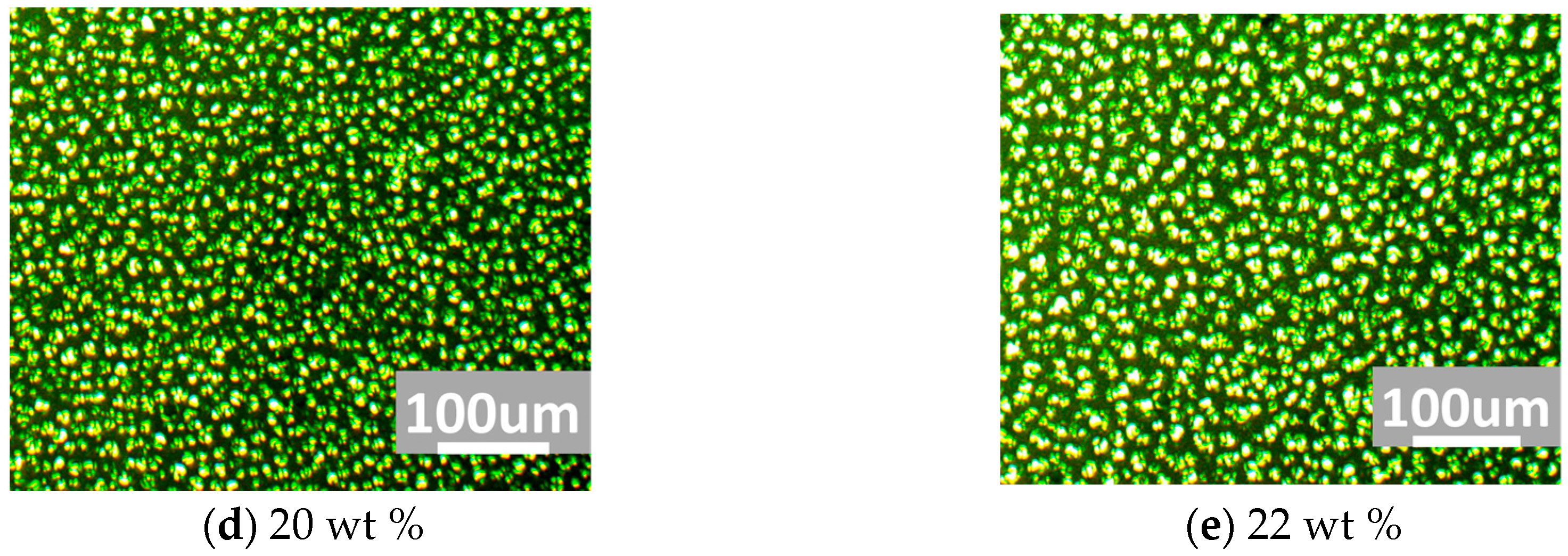
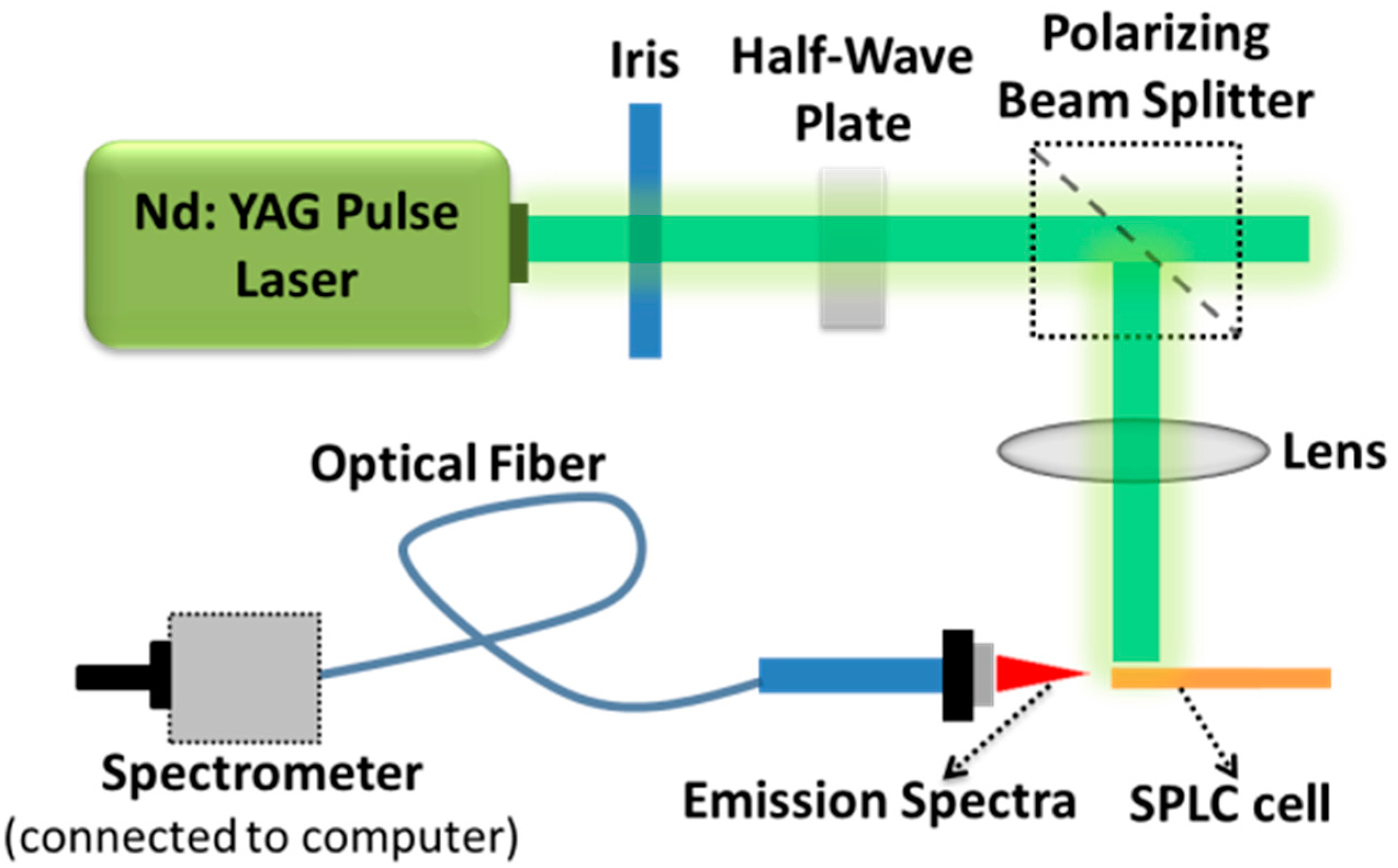
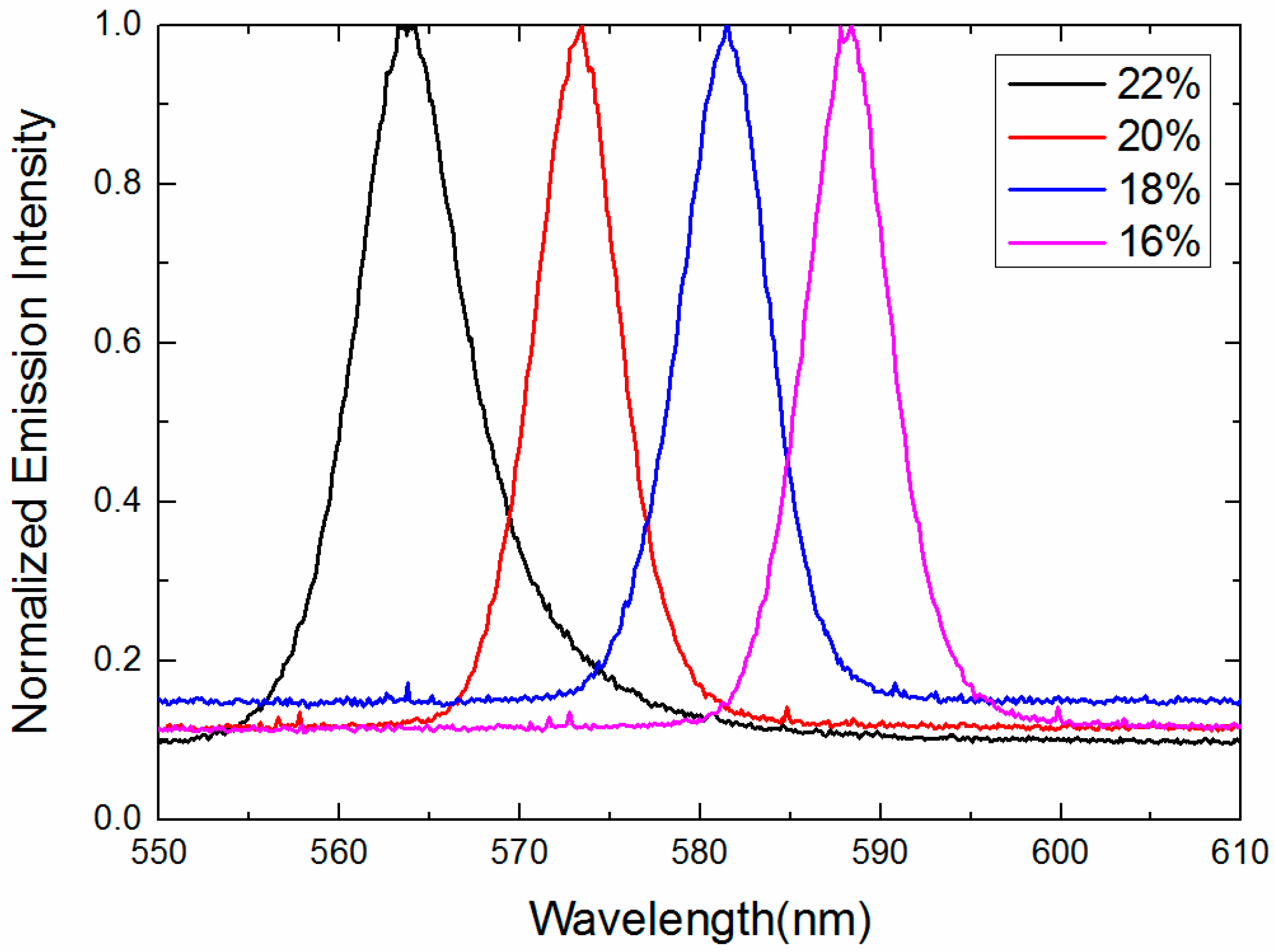

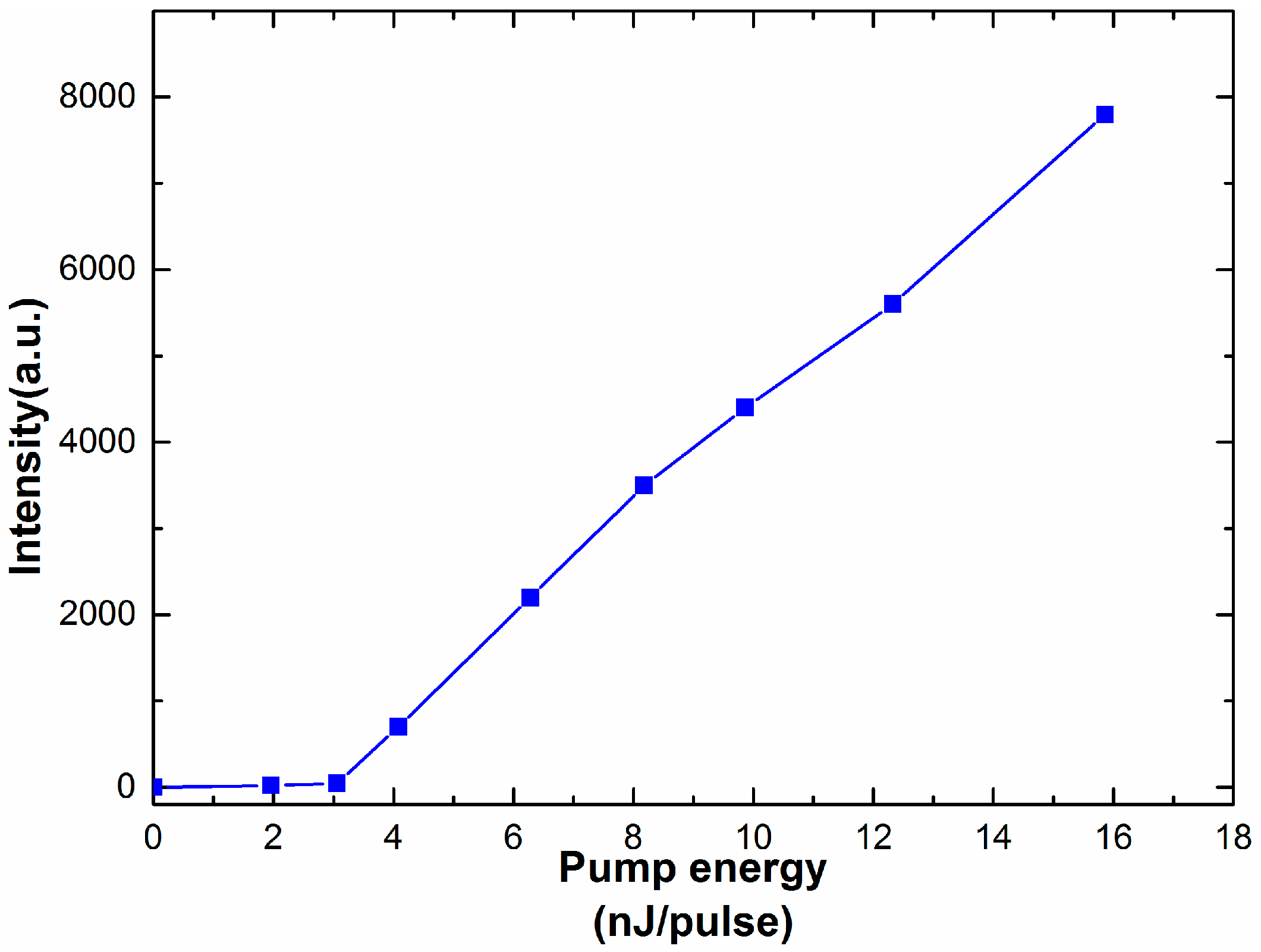
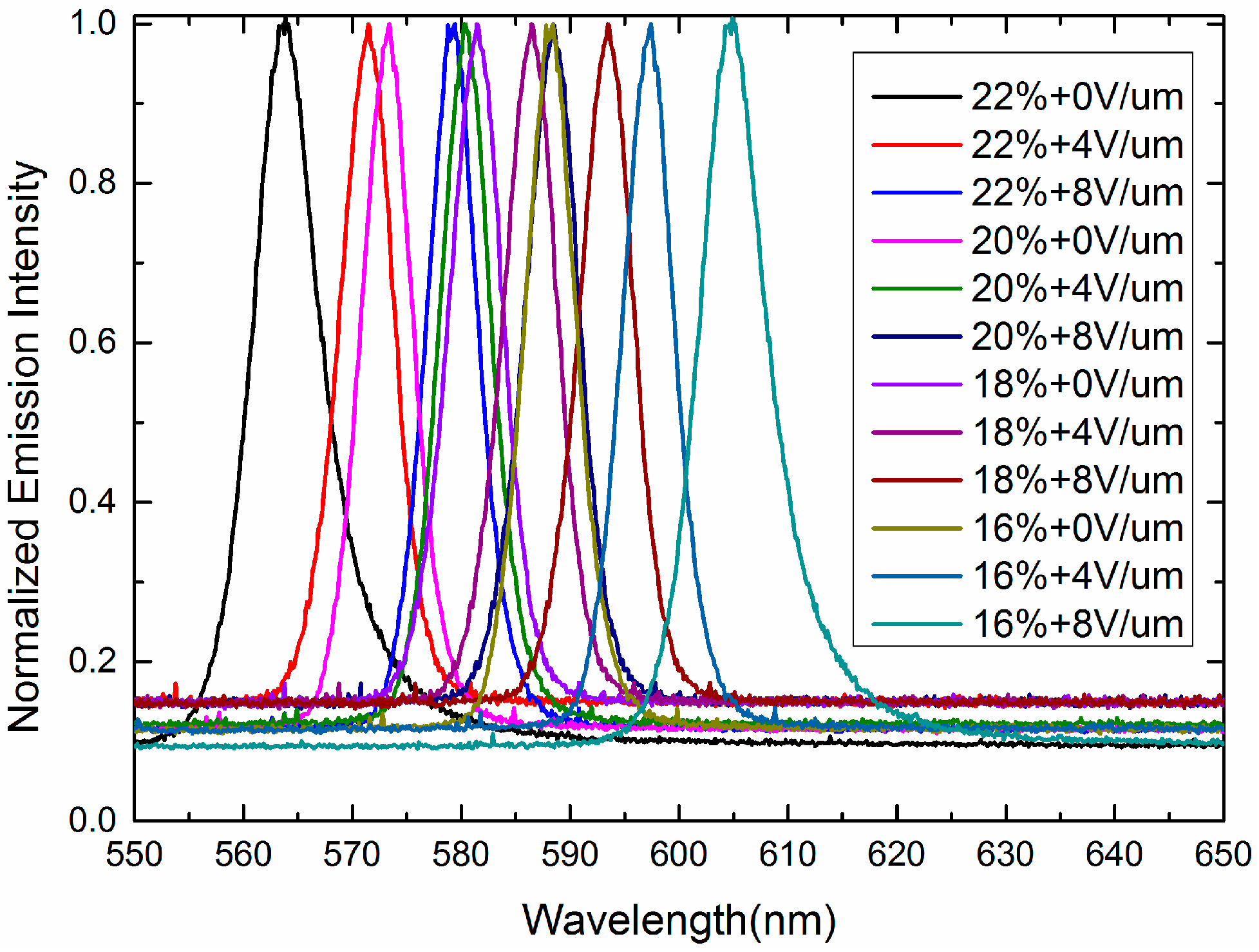

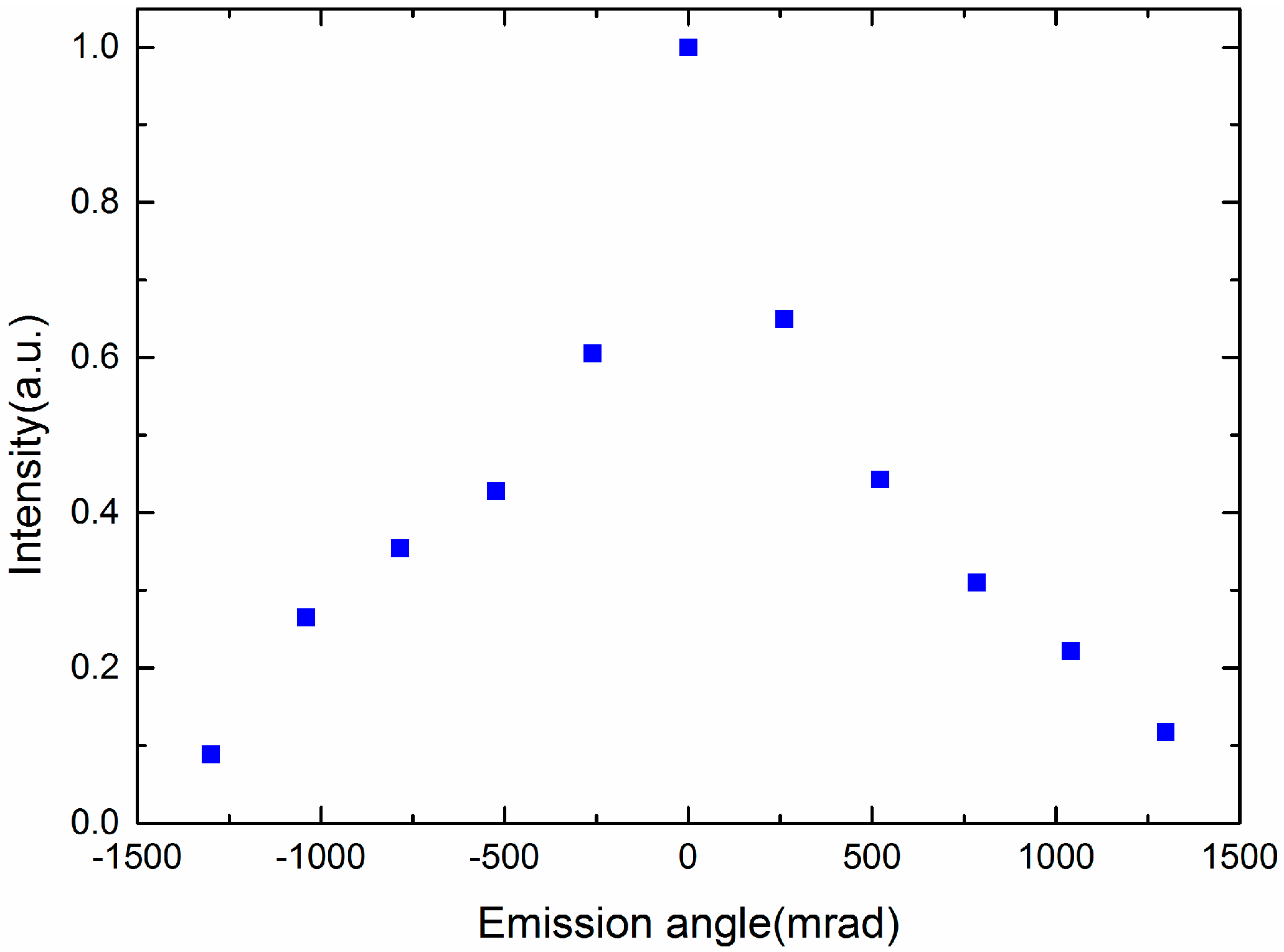
| Polymer Concentration | 14 wt % | 16 wt % | 18 wt % | 20 wt % | 22 wt % |
|---|---|---|---|---|---|
| SP001 (wt %) | 81.89 | 79.67 | 77.63 | 75.79 | 73.93 |
| R5011 (wt %) | 3.97 | 4.09 | 4.24 | 4.38 | 4.52 |
| RM257 (wt %) | 7.03 | 8.20 | 9.13 | 10.12 | 10.78 |
| 12A (wt %) | 7.01 | 8.04 | 8.90 | 9.61 | 10.67 |
| IRG184 (wt %) | 0.1 | 0.1 | 0.1 | 0.1 | 0.1 |
© 2017 by the authors. Licensee MDPI, Basel, Switzerland. This article is an open access article distributed under the terms and conditions of the Creative Commons Attribution (CC BY) license (http://creativecommons.org/licenses/by/4.0/).
Share and Cite
Chen, Z.; Hu, D.; Chen, X.; Zeng, D.; Lee, Y.; Chen, X.; Lu, J. Templated Sphere Phase Liquid Crystals for Tunable Random Lasing. Nanomaterials 2017, 7, 392. https://doi.org/10.3390/nano7110392
Chen Z, Hu D, Chen X, Zeng D, Lee Y, Chen X, Lu J. Templated Sphere Phase Liquid Crystals for Tunable Random Lasing. Nanomaterials. 2017; 7(11):392. https://doi.org/10.3390/nano7110392
Chicago/Turabian StyleChen, Ziping, Dechun Hu, Xingwu Chen, Deren Zeng, Yungjui Lee, Xiaoxian Chen, and Jiangang Lu. 2017. "Templated Sphere Phase Liquid Crystals for Tunable Random Lasing" Nanomaterials 7, no. 11: 392. https://doi.org/10.3390/nano7110392
APA StyleChen, Z., Hu, D., Chen, X., Zeng, D., Lee, Y., Chen, X., & Lu, J. (2017). Templated Sphere Phase Liquid Crystals for Tunable Random Lasing. Nanomaterials, 7(11), 392. https://doi.org/10.3390/nano7110392





